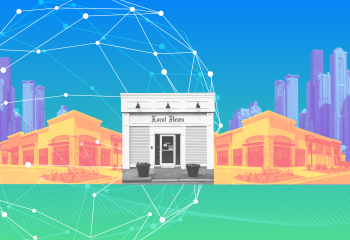
News Literacy Boosts Trust in Local News
After I was asked to write this piece about trust and local news, I recalled that CBS Evening News anchor Walter Cronkite was, for years, described as “the most trusted man in America,” based on the results of a 1972 survey. As I looked for more information, I discovered, thanks to articles in The New Yorker and Slate, that the survey was flawed: Cronkite was the only non-politician listed (others included President Richard Nixon, Vice President Spiro Agnew and assorted candidates for president, senator and governor).
The idea that this description persisted throughout the venerated newsman’s career and beyond intrigued me, because my work at the News Literacy Project is focused on helping students decipher fact from fiction. Had I not checked, I would have inadvertently spread misinformation.
That said, Cronkite was trusted by many Americans, for good reason. His was the voice we turned to during trying times — the assassinations of President John F. Kennedy and Martin Luther King Jr., the Vietnam War, Watergate. And, with an average nightly audience of between 27 million and 29 million viewers, it’s no wonder that many Americans found him to be a reliable source of information.
In 1980, when Cronkite announced his retirement, the combined ratings for the national evening news programs on ABC, CBS and NBC totaled 42.3 (ratings are the percentage of households with a TV tuned into a program). By 2005, that figure had fallen to 18.9 – and the latest Pew Research data shows that evening news programs averaged 5.3 million viewers in 2018. Americans were no longer having a shared news experience and getting a consensus national narrative of the big events of the day. The proliferation of cable news networks, online news sites, social media, podcasts and blogs enabled many more perspectives to be heard.
In many ways — such as the increased diversity of backgrounds and experiences of those delivering the news — this development was positive. But it also contributed to the rise of hyper-partisanship, as audiences were increasingly able to watch, hear or read the news presented by outlets that reflected their own ideological leanings.
How do we combat this polarization? Here’s one idea: Keep local news organizations strong.
A study published in December 2018 in the Journal of Communication connected the dots. The authors posited that because the internet offers an unlimited stage to national media outlets. This means that national political news — which often focuses on partisan conflict — is inescapable. So they followed a hunch: If people are consuming more nationalized news when their local newspapers decline, they might become more polarized themselves and vote accordingly.
To test this, they compared voting patterns in the 2012 election in counties that had lost a local newspaper and ones that had not. Their conclusion: “Local newspapers provide a valuable service to democracy by keeping readers’ focus on their communities. When they lose local newspapers, we have found, readers turn to their political partisanship to inform their political choices.”
The destruction of the business model (advertising and circulation revenue) that sustained local newspapers for decades has caused hundreds of publications to fold in recent years, and many of the survivors have experienced repeated rounds of layoffs, gutting the news staffs. Yet in spite of those cuts, people continue to trust their local news organizations. The 2018 Poynter Media Trust survey (PDF download) found that “76% of Americans across the political spectrum have a ‘great deal’ or a ‘fair amount’ of trust in local television news, and 73% do so for local newspapers.”
With that strong foundation in place, we can build on the public’s trust in standards-based news organizations by creating a new generation of news readers, viewers and listeners — one that understands and appreciates quality journalism and the factors that distinguish it from the information (and misinformation) that competes for, and often overwhelms, consumers’ attention.
This is what the News Literacy Project does. We equip and empower educators to teach students the skills they need to become smart, active consumers of news and other information – and engaged, informed participants in civic life. Our approach helps young people build the critical-thinking skills that will last them a lifetime.
For example, our Newsroom to Classroom program gives journalists the opportunity to visit schools and talk about what they do, how they do it and why it matters. These visits, either in person or virtually, allow students and educators to engage with journalists in a mutually beneficial dialogue on topics of interest to both sides. Ultimately, this kind of engagement creates knowledge of how the process works and a greater transparency that encourages trust. (In fact, the idea for the News Literacy Project grew out of a visit I made to my daughter’s school in 2006, when I was a reporter at the Los Angeles Times.)
Supporting news literacy education at the local level will lead to deeper interest in the work of local news outlets — the ones that hold local businesses and local elected officials accountable. When news consumers learn how to verify the credibility of information, they become empowered. Our students tell us that as a result of lessons in our Checkology® virtual classroom, they plan to become more engaged in civic issues and more active in their communities.
It’s essential that we maintain trust in our institutions — particularly our local news organizations, which are accessible, accountable and best equipped to inform us about what’s happening in our communities.
Walter Cronkite’s signature signoff was: “And that’s the way it is” (you can look this one up!). We believe that if we make news literacy a part of every young person’s education, we can have greater confidence that the next generation indeed will be able to determine “the way it is.”
Alan C. Miller is the founder and CEO of the News Literacy Project. Visit newslit.org to find out how your newsroom can work with NLP to build news literacy skills.
YOU MAY ALSO BE INTERESTED IN…
Recent Content
-
Journalismarticle ·
-
Journalismarticle ·
-
Journalismarticle ·





